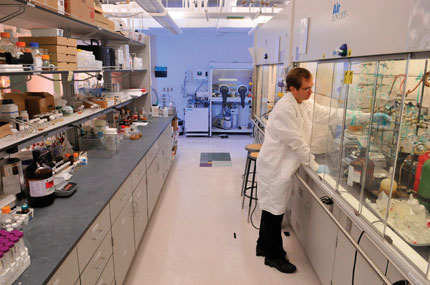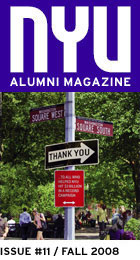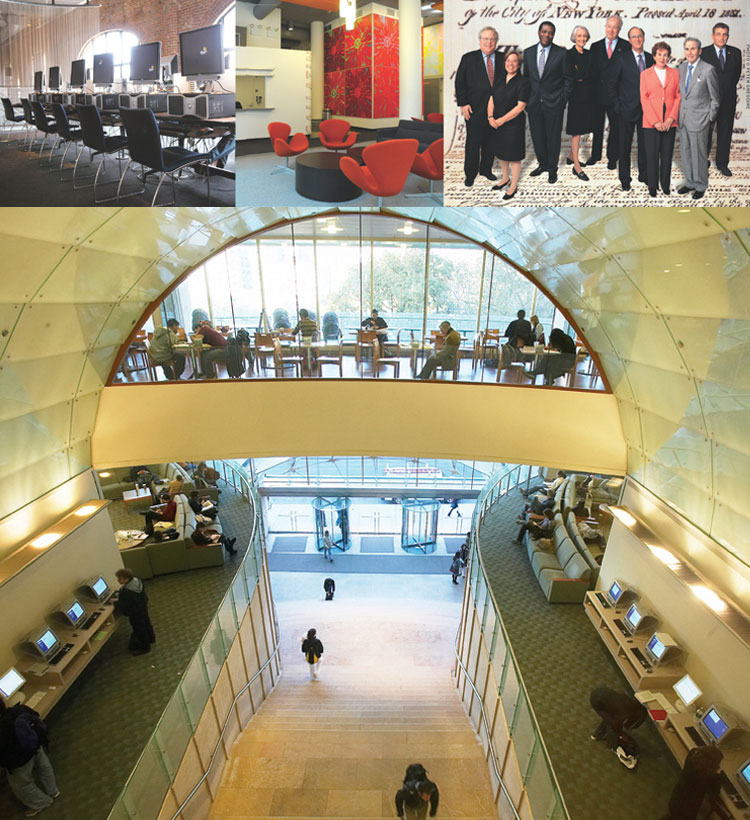View From the Finish Line
After an unprecedented campaign that boosted the endowment, transformed the academic community, and mobilized alumni everywhere, NYU is Poised to take its next giant leap
by Courtney E. Martin / GAL'04
Above left: The journalism department's state-of-the-art new home at 20 Cooper Square. Above middle: The Gallatin School of Individualized Study recently underwent a $27 million “green” redesign Above right: NYU's “Founding Partners,” from left: William Berkley (STERN '66), Marjorie Berkley, Anthony Welters (LAW '77), Susan Lipton, Martin Lipton (LAW '55), Laurence Fink, Helen Kimmel, Martin Kimmel and Leonard Wilf (LAW '77). Not pictured: Lori Fink, Beatrice Welters and Beth Wilf. Below: The grand entrance to the Helen and Martin Kimmel Center for University Life.
The last campaign had raised $1 billion over a decade and, while bold then, times had changed. By the new millennium, NYU had propelled itself into the league of major research universities, and though its reputation was rising—it was consistently among the top “dream schools” for college–bound high school students—the university’s endowment was a fraction of that of competitors such as Yale, Harvard, and Princeton, financial aid resources were lacking, and its facilities were in need of serious renovation. Another ambitious fundraising campaign appeared the only way to keep pace.
That “Campaign for NYU” ended this fall and the university reports that it didn’t raise $2.5 billion—but, rather, more than $3 billion. In the process, it also united a large and far–flung body of alumni who span the globe and generations. It energized the parents of current students and even inspired those with no prior affiliation with NYU to invest in the university’s future. In total, 476,444 gifts were given to the school over seven years, a rate of nearly 200 per day.
To inspire this degree of engagement, the university had to cultivate belief in the mission and a common sense of identity among alumni, whether one haunted Washington Square or the old Heights campus, was a commuter student during leaner years or a more recent transplant. “People don’t wake up in the morning and decide they want to give money to anything, NYU or otherwise,” says Ehrenkranz, who chaired the campaign. To make this connection, President John Sexton started sharing his vision of NYU as a global community while giving his trademark bear hugs from San Diego to Stamford to Shanghai. At regional meetings with faculty, alumni, parents, and friends, he routinely asked the oldest and youngest alumni to stand side by side as a physical reminder of the bridges the university was building.
In the process, several new centers of community building emerged, from the Young Alumni Leadership Circle, or YALC, founded in 2003 for those alumni who graduated within the last 15 years, to the Parents’ Committee, which offers parents an official role in advocating for their children’s interests on campus. YALC, for example, has grown from 30 original members to more than 400 and is preparing the next generation of university leadership by offering the chance to network with trustees and others. Meanwhile, the Parents’ Committee not only hosts welcome receptions for incoming students around the country but has become an invaluable engine of support. Due to this and other efforts, gifts from parents have increased by 436 percent since the campaign started.
Back in Washington Square, however, the university has had to create connections of a different sort between NYU’s various schools and programs, each with their own needs. Seven years ago, LaMorte began by simply breaking bread with the deans and asking them, “What’s your vision? Where do you want to see this school in five years?” They told her about aspirations for cutting–edge research, deeply committed instructors, improved computer labs, and a more diverse student body. LaMorte listened, lunch after lunch, and started recognizing common themes, which became the five key areas of the campaign: investing in faculty, increasing scholarships and fellowships, enhancing curriculum and programs, improving the physical campus, and cultivating alumni participation. “We didn’t want this campaign to have a gimmicky feel,” LaMorte explains. “Instead, we wanted to raise the bar on fundraising at NYU from a place of shared vision and genuine relationships.”
 The Department of Chemistry’s Molecular Design Institute, which unites faculty with expertise in the design and synthesis of complex molecular and supramolecular architectures, opened in May 2007.
The Department of Chemistry’s Molecular Design Institute, which unites faculty with expertise in the design and synthesis of complex molecular and supramolecular architectures, opened in May 2007.
One of the more visible manifestations of the campaign is the Gallatin School of Individualized Study, where a $27 million redesign has already transformed the school’s cramped quarters at 715 Broadway into a fluid—and “green”—center. The new space, with its student lounges, theater, and gallery spaces, was laid out to “offer more opportunities for forging connections” and “encourage collaboration,” Dean Susanne Wofford explains. The same goes for the journalism department’s new home at Cooper Square, the labs for the Center for Comparative Functional Genomics in the Brown Building, and the Joan and Joel Smilow Research Center at the NYU Langone Medical Center.
But it takes more than just reconfiguring space to transcend the silos of individual schools and disciplines. The campaign supported new initiatives to link students and faculty, such as the Catherine B. Reynolds Foundation Program in Social Entrepreneurship, which is administered by the Robert F. Wagner Graduate School of Public Service and recruits undergraduates and graduates from all of NYU’s schools and supplies financial support while they study a curriculum for changing the world with classes in finance, law, social work, and more. Other unions have grown, too: the Tisch School of the Arts and Leonard N. Stern School of Business now offer a joint MFA/MBA, the master’s program in Global Public Health and the Institute for the Study of the Ancient World conduct research from a variety of disciplinary angles, and there are new collaborations between the Courant Institute of Mathematical Sciences and the Langone Medical Center toward advancing health–care research.
Walking around campus today, it’s hard to miss the changes that have taken place in the past seven years. New buildings, such as the Helen and Martin Kimmel Center for University Life and Furman Hall, stand alongside grand old structures sporting refurbished or brand–new rehearsal and study spaces, state–of–the–art research centers and labs, and an array of libraries. And many new faces can be spotted throughout Washington Square, thanks to the more than 700 additional scholarships that were created and the scores of faculty hired. Perhaps that’s the most important result of this mammoth effort. Money, after all, is only the tool; a strong community of learning is the ultimate goal.
all photos except when indicated courtesy nyu; Photo TOP RIGHT Peter Gregoire
$2.5 billion in seven years. “It was as close to an audible gasp as you can imagine.”








